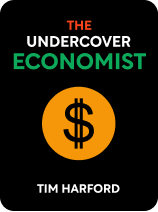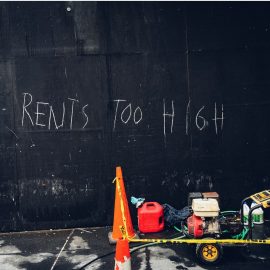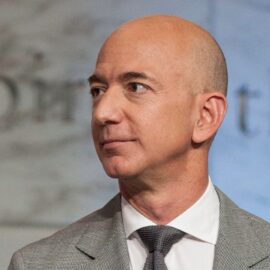

This article is an excerpt from the Shortform book guide to "The Undercover Economist" by Tim Harford. Shortform has the world's best summaries and analyses of books you should be reading.
Like this article? Sign up for a free trial here .
How do economies work? What are the universal principles that apply to all economies of the world?
In his book The Undercover Economist, Tim Harford provides a clear and down-to-earth explanation of how an economy works. He distills seven basic economic principles and illustrates how they manifest in real-world economies.
Keep reading to learn about Tim Harford’s economic principles: scarcity, price targeting, externalities, missing information, the stock market, game theory, and globalization.
Understanding the Basic Economic Principles
The Undercover Economist, written by economist Tim Harford, will help you think like an economist without boring you with endless graphs or complex math. The world functions on basic economic principles. By thinking like an economist, you’ll learn how to make better decisions every day. This book will help you understand why you make the economic decisions that you do and discuss what happens when the economic principles that efficiently govern much of the world break down.
It’s unlikely that you think much about economics when buying a cappuccino. Getting a coffee is probably part of your routine, and you can get a similar product at thousands of places around the U.S. But when an economist sees your coffee, she understands that even this everyday product is the result of the effort of a lot of people. In other words, no single individual or group is in charge of any sector of the economy: No one makes a coffee from beginning to end. This would take growing and picking the coffee beans, buying, milking, and generally caring for cows, building a coffee machine with all of the steel parts necessary, and throwing a nice cup on the wheel and putting it into a kiln that you’ve also built, all with clay that you’ve harvested yourself.
The system through which you get your coffee is incredibly complex and has evolved over centuries if not millennia. It also generally works well, but it sometimes breaks. The rest of the book will explore how economies work well and what happens when they don’t, using these basic economic principles as a guide:
- Scarcity
- Price Targeting
- Externalities
- Missing Information
- The Stock Market
- Game Theory
- Globalization
We’ll also discuss how these principles affect everyday economic questions like how to fix America’s healthcare system, why poor countries like Cameroon stay poor, and what is behind China’s meteoric rise as an economic power.
Everyday Economic Principles
In this section, you’ll learn the basics of some essential economic models. After reading, you will have a better understanding of how scarcity, competition, and marginal land principles function and how to apply these principles to real-life situations.
Scarcity and Wheat in Britain
The first important economic principle that we’ll examine is scarcity: the idea that strength in negotiation comes from having a scarce resource that others want. Let’s say a wheat farmer is looking for land, and there are a lot of landlords who have land available. In this case, the landlords will attempt to undercut one another to get the wheat farmer’s business, making the land cheap. However, seeing the success of one wheat farmer, more people want to farm wheat in the town, and the scarcity shifts. Now, it’s the land, rather than the farmer, that is the scarce resource. Landlords get increasingly more power and can start to charge higher prices.
The balance of power between the farmers and the landlords can shift quickly. If farmers decide that the landlords’ prices are too high for them to make money on the most fertile land in town (the meadowland), there won’t be any incentive for them to rent from the landlords. They’ll be more likely to rent from the landlords of less fertile land like grassland. These farmers may produce less wheat, but their costs will be lower, making up for the decrease in revenue. The shifts in the scarce resource between farmers and landlords have the potential to go on forever. Once farmers take up all of the meadowland and grassland, and a new aspiring farmer arrives, he’ll rent from the landlords of even less-fertile land like scrubland.
The scrubland, or the lowest-yielding land, is called the marginal land. The marginal land will always necessarily be the least profitable. This example illustrates why. Let’s say the new farmers are making $10,000/year on the scrubland, and the old farmers are making $15,000/year on the grassland. If neither farmer is paying anything in rent, the grassland is more profitable. But if the grassland landlords are charging $7,500/year in rent, the old farmers would only take home $7,500/year in profits. If the scrubland was free to farm, the old farmers would all move to the scrubland, because they could take home $10,000/year. Thus, the grassland landlords charge only $5,000/year or less to keep their farmers, because the farmers are only willing to stay if they can make at least as much as they would have made farming scrubland ($10,000/year in profit).
Modern-Day Coffee Shops
We can apply this understanding to coffee shops in cities.
Nearby most train stations in the world are coffee shops. Because of their prime location, they can charge more money for their coffee than other coffee shops in less busy transverses. Busy commuters don’t want to look for a coffee place that will take them out of their way and cost them time. Instead, they’re willing to pay the markup for the convenient location.
This markup is made with the full implicit understanding, amongst everyone involved, that coffee doesn’t actually cost much money to make, especially if it’s being done on a large scale like at a Starbucks. The margins get significantly bigger when places have a location near a busy place like a train station and can thus charge higher prices.
However, finding a good location is expensive itself. There are many coffee places that would want a storefront next to Penn Station in New York, for example. So the landlords have the advantage in this interaction, and they can ratchet up the price for their in-demand storefront.
You’ve probably heard that coffee costs a lot of money in cities because coffee shops pay more money in rent so they charge higher prices. But this explanation doesn’t account for why rent is high in the first place. Locations only become “prime” if customers are willing to pay a lot of money for coffee. So it’s actually the other way around: Customers during rush hour are willing to pay a lot of money for coffee if it’s convenient. This allows landlords to charge a high price because they own valuable land.
Two Kinds of Profit-Building
There are many reasons things are expensive. Returning to the original farmer and wheat example, at the most basic level, prime land will be more expensive because it can produce more profit.
We can apply this model to all businesses. The first kind of profit-building is providing the best services. Sometimes, the most successful businesses make the most money because they have the best business model and consumers want to pay more for their services. If there are three banks, one of which is well respected, one of which is fairly well respected, and one of which is not well respected, then the first bank will likely make good margins. If interest in the banks’ services increases, then the market will dictate that an even less reputable bank will open. This is just like the example of marginal land. As interest in a business increases, increasingly less desirable land (or services) will enter the market. While the amount and type of land are fixed and the competency of a company is not, it’s difficult to build a trusted and competent company, making quality somewhat fixed as well. Thus, the model works for short- and medium-term scenarios.
However, this model can break down over the long-term. The second kind of profit-building involves companies working with the government or each other to increase profits. Let’s say all of the landlords band together and successfully convince the city to outlaw farming on the marginal land, citing the protection of wilderness. This will drive up the price of their land even more because there won’t be an alternative for farmers, and they’ll have to bid on the existing land.
This sort of legislation happens constantly. In most major cities, there are zoning restrictions that prevent developers from building large buildings in certain parts of the city. Paris is the most extreme example—within the city limits, there are laws limiting the height of buildings after a backlash to skyscrapers built there in the 1960s and 70s. But a lot of people still want to live in Paris. The housing stock of the city is thus extra valuable because there isn’t much of it.
This has wide-reaching implications. Many of the suburbs right outside of Paris have tall buildings to accommodate more office space and people. Additionally, these regulations create some strange incentives. Landlords who own buildings inside of the Paris city limits aren’t likely to support initiatives to improve transportation in and out of the city, because that will make people more willing to live somewhere else.
This is true in industries that don’t involve land as well. Firms will often lobby governments to artificially protect them from competition. If governments, for whatever reason, acquiesce, these firms set their own prices without competition and make a lot of money. These sorts of profits are called “monopoly rents.” Governmental intervention can make goods expensive for consumers.
Preventing Competition
To increase profits, many industries try to avoid competition, but they often fail. Think about the oil industry in the 1970s. Oil-producing countries banded together to form the Organization of Petroleum Exporting Countries (OPEC), which began to restrict oil production. Oil prices around the world thus ballooned because the resource was scarce. But as the oil prices got much higher, it became clear that it would be cheaper to find different sources of energy and new places to extract oil where before these methods seemed too expensive. Oil drilling began in Alberta and Alaska and the coal industry grew significantly to prove an alternate energy source to oil.
By drilling and expanding alternative energy sources, other countries forced OPEC into a smaller oil share, until finally, Saudi Arabia agreed in 1985 to expand oil production again. This drove oil prices back down significantly. Still, producing oil is so cheap for most OPEC countries that even when oil prices were down, given that they had the best land, they made by far the most profit.
The same sort of attempts at competition-prevention happen in other industries. Trade unions are set up to bargain as a group but also to block people not in the union from entering the market and competing with them. However, this is not always so easy. Trade unions with inflated wages can expect international competition and government attempts to regulate their union to stand in the way of their success. In the U.S. car industry, for example, demand has vanished for auto workers as more cars can be made more cheaply overseas, in places without trade unions that are inflating salaries for their workers.
Immigration
The same sort of competition extends to immigration. Well-educated, white-collar workers in the United States generally welcome more immigration into the U.S. from unskilled workers, because they believe this process to be a public good: It gives people opportunities to change their fortunes and enriches the U.S. by adding different cultures and outlooks on the world to the country.
However, more poorly educated workers are less likely to be willing to support immigration because they are concerned about competition from immigrants. Well-educated workers become more scarce relative to the general population if we’re letting in less-educated immigrants, whereas less-educated workers become less scarce. The last batch of unskilled immigrants is most likely to be harmed by an expansion of unskilled immigration because their jobs or wages might be at risk if they are no longer scarce.
A Note on Complexity
Critics of economics argue that the discipline robs situations of their complexity. They believe that using the old model of farmers and land to explain 21st-century economics is reductive and doesn’t consider all kinds of factors like government intervention or how people’s behaviors change based on various external factors. They argue additionally that not everyone is always perfectly self-interested, which many economic models presume.
Harford responds to this by saying that everything is complicated, but to understand larger systems, we have to simplify and focus on certain parts of these systems. By focusing specifically on economic systems, we can gain a much more comprehensive understanding of the way the world works than most people would assume. The basic farmer-and-land model goes far, and, as we’ve seen, can explain phenomena like why unskilled laborers object to immigration policies that promote other unskilled workers.
There also exists the question of what economists should do with this information. Often, economists move beyond just modeling information and become public policy advocates, lobbying the government based on their research to pursue policies like expansions of free trade.

———End of Preview———
Like what you just read? Read the rest of the world's best book summary and analysis of Tim Harford's "The Undercover Economist" at Shortform .
Here's what you'll find in our full The Undercover Economist summary :
- How to think like an economist
- How to use principles like scarcity, price targeting, the stock market, and game theory to make better decisions every day
- Why the economy is mostly about people, not complex math, graphs, or jargon






